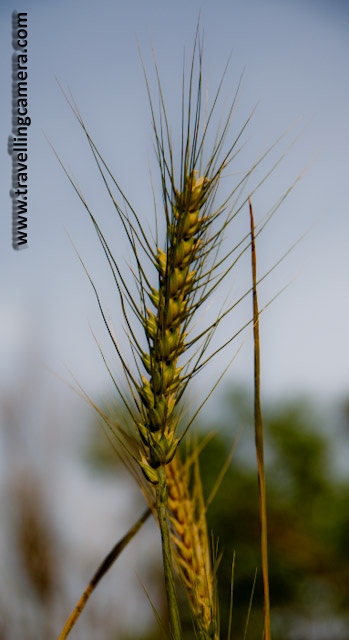Here are few Photographs which give a view of farming land near Baisakhi time...
Baisakhi is an ancient harvest festival in the Punjab regions which also marks beginning of the second month on the solar calendar and new harvest season. Baisakhi is also a Sikh religious festival. Some of the areas(Kangra region) in Himachal actually belongs to Old Punjab...

Rabi Crops ready for harvesting... Note some green areas in this field... areas under shadow takes more time as compared to crops in open area...
Wheat...
Baisakhi is also observed as the beginning of the Hindu solar new year celebrated by the people of Nepal and India in Kerala, Orissa, West Bengal and some other regions of India. The particular significance attached to the occasion shows regional variation outside of Punjab too.
In Himachal Pradesh, the Hindu Goddess Jwalamukhi is worshipped on Baisakhi, while in Bihar, the Sun-god Surya is honoured.
The festival is celebrated as Rongali Bihu in Assam, Naba Barsha or Pohela Boishakh in Bengal, Assam and Tripura, as Bikhu or Bikhauti in the Kumaon region of Uttarakhand, Puthandu (Tamil New Year) in Tamil Nadu, Vishu (or Vaishakhi) in Kerala, Maha Vishuba Sankranti (or Pana Sankranti) in Orissa, and the Sinhala and Tamil new year festival in Sri Lanka.
Besides Punjab, Baisakhi is widely celebrated as traditional harvest festival in many northern states of India, such as Haryana and Himachal Pradesh. In many places the day is marked by ritualistic bathing in sacred rivers like the Ganges.
Wheat grain is a staple food used to make flour for leavened, flat and steamed breads, biscuits, cookies, cakes, breakfast cereal, pasta, noodles, couscous and for fermentation to make BEER...
Wheat is planted to a limited extent as a forage crop for livestock, and its straw can be used as a construction material for roofing thatch
Hybrid wheat grass which is easy to harvest...
According to the Gregorian Calendar Baisakhi falls on April 13 every year and on April 14 once in 36 years. This variation in date is due to the fact that the date of Baisakhi is reckoned according to the Indian solar calendar and not the lunar calendar.
Normal wheat grass, which is difficult to harvest and painful for framer to deal with it...










.jpg)
Comments